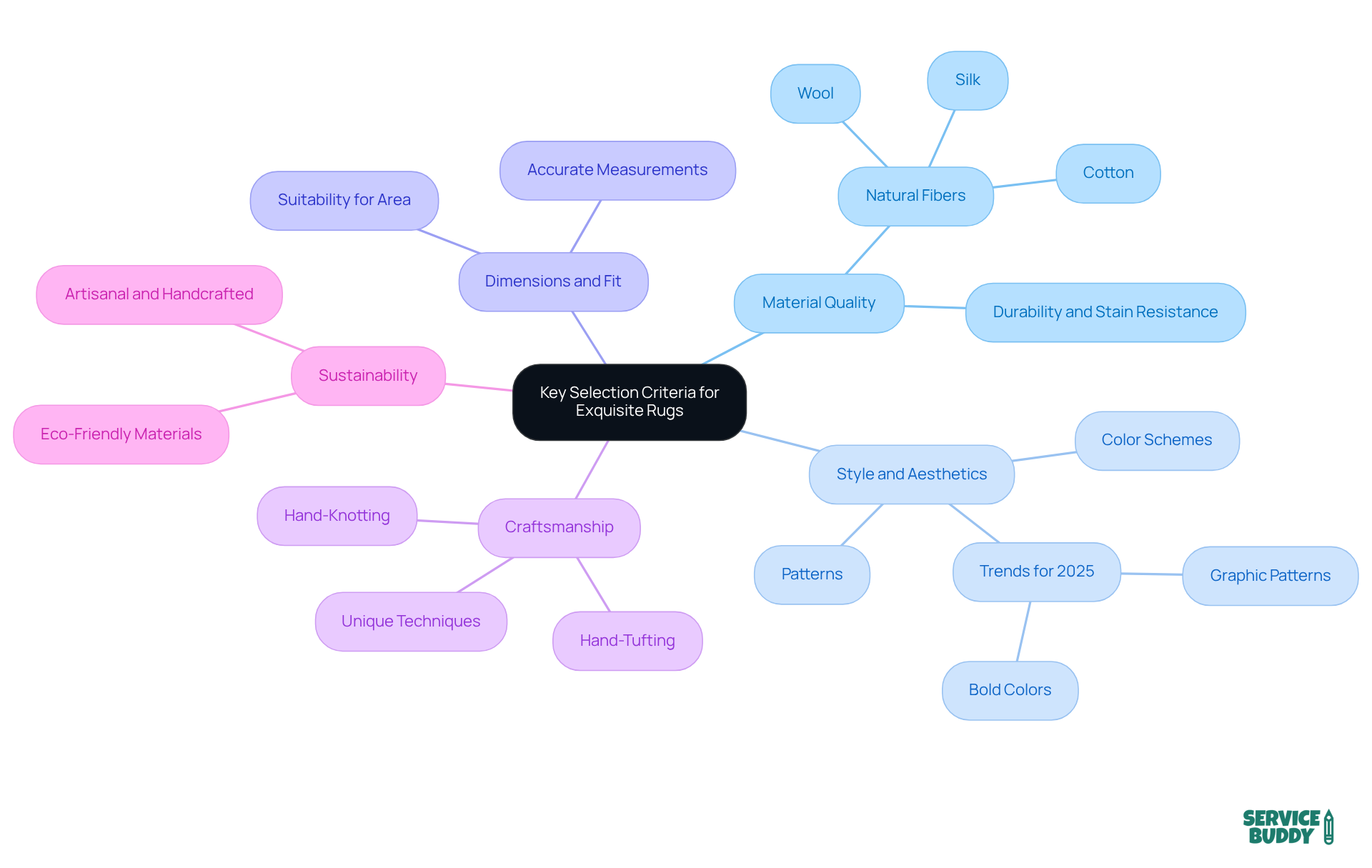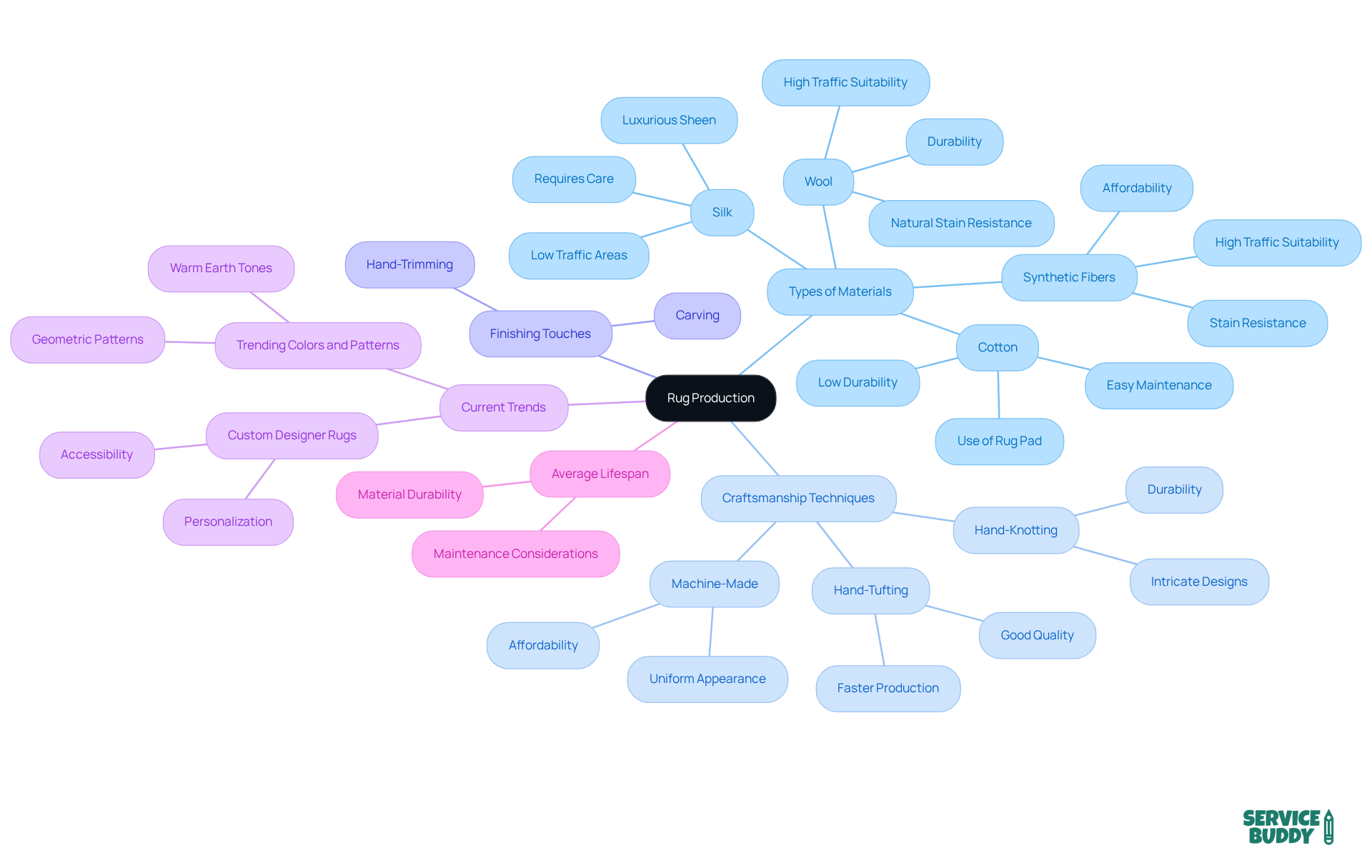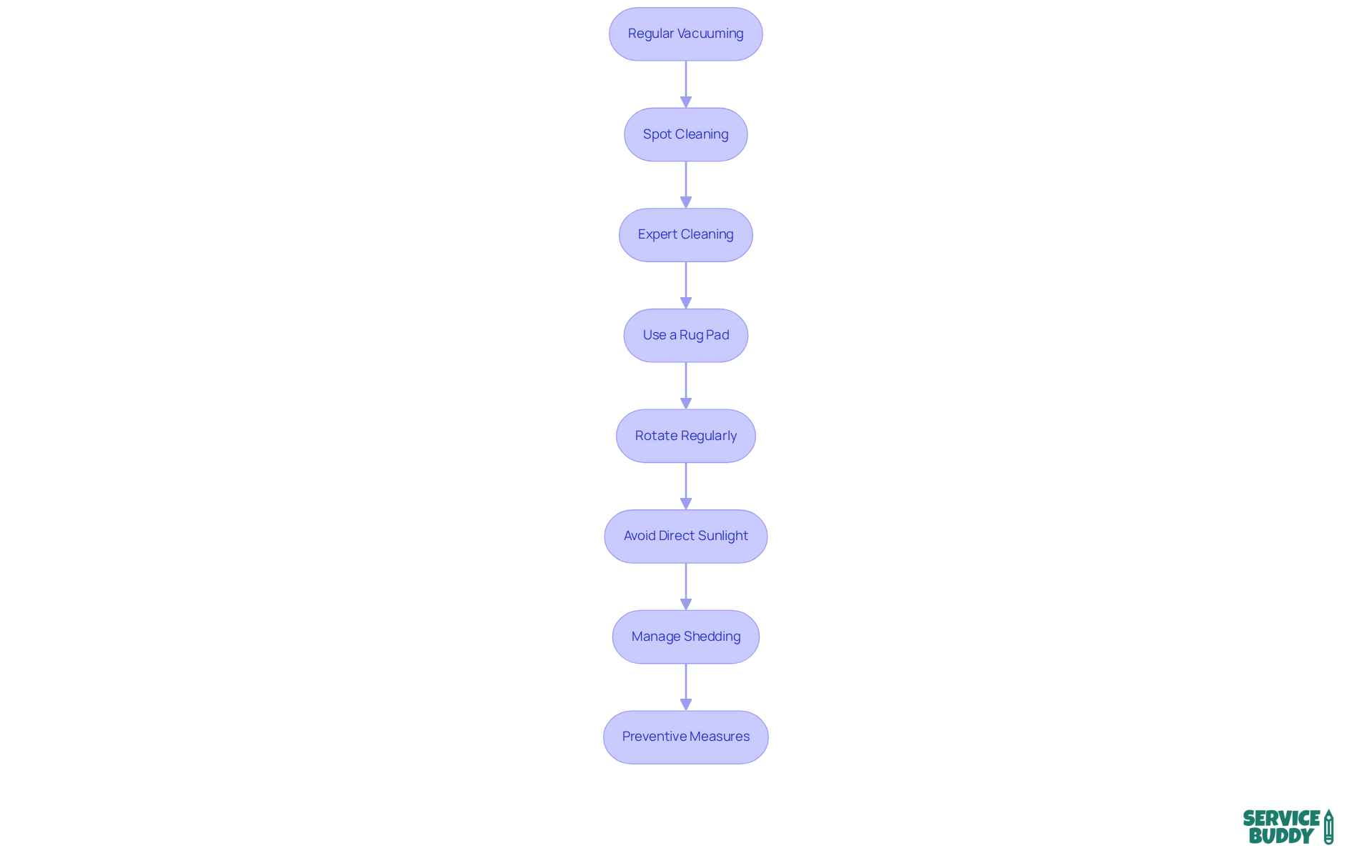Overview
This article delves into essential practices for selecting, caring for, and maintaining exquisite rugs within a business context. It underscores the critical importance of material quality, craftsmanship, and sustainability in the selection process. Effective care practices, such as regular vacuuming and professional cleaning, are outlined to enhance the longevity of rugs. By ensuring these elements are prioritized, businesses can achieve customer satisfaction and drive success.
Understanding the nuances of rug care is vital for flooring business owners. The right materials and craftsmanship not only elevate the aesthetic appeal but also contribute to a sustainable business model. Regular maintenance practices are not just recommendations; they are necessities that directly impact customer experience and retention.
Incorporating these practices into your business strategy can yield significant benefits. By prioritizing quality and care, you position your business for long-term success, fostering loyalty among customers who value excellence. This proactive approach not only enhances the lifespan of your products but also solidifies your reputation in the industry.
Ultimately, the commitment to maintaining exquisite rugs is a commitment to your business's future. Embrace these practices to ensure that your flooring solutions stand out in a competitive market.
Introduction
Selecting the perfect rug can transform a space, but this process encompasses more than mere aesthetics. Flooring professionals must navigate a complex landscape of materials, craftsmanship, and market trends to curate a collection that resonates with discerning customers.
What essential practices can elevate a business's rug offerings and ensure longevity and satisfaction? This article delves into the critical criteria for choosing exquisite rugs, from understanding material quality to implementing effective care strategies.
These insights are invaluable for those looking to excel in the competitive rug market.
Identify Key Selection Criteria for Exquisite Rugs
When selecting exquisite rugs for your business, it is essential to consider the following key criteria:
- Material Quality: Prioritize natural fibers such as wool, silk, or cotton. Wool is often regarded as the due to its durability and natural stain resistance, as noted by Linda Alexanian, a third-generation rug merchant. High-quality materials not only enhance the rug's longevity but also its visual impact.
- Style and Aesthetics: Choose styles that resonate with your target market. Pay attention to color schemes, patterns, and styles that align with the latest interior decoration trends, such as the growing popularity of graphic patterns and bold colors in 2025. The Carpets & Rugs market in the United States attained a revenue of US$17.85bn in 2025, emphasizing the significance of attractive styles in a profitable market.
- Dimensions and Fit: Ensure that the carpets are suitably sized for the intended area. Accurate measurements are crucial to avoid mismatches that could detract from the overall design and functionality of the area.
- Craftsmanship: Seek out textiles that exhibit superior craftsmanship, such as hand-knotting or hand-tufting. These techniques often indicate higher quality and uniqueness, appealing to discerning customers.
- Sustainability: With a growing consumer emphasis on sustainability, obtaining carpets crafted from eco-friendly materials can improve your brand's reputation and draw in environmentally aware purchasers. This corresponds with the trend towards artisanal, handcrafted textiles that emphasize natural materials.
By focusing on these criteria, flooring experts can assemble a collection of exquisite rugs that not only satisfy customer expectations but also enhance their business offerings. Additionally, successful flooring retailers often prioritize adaptable neutrals, as seen in the Adaptive Neutrals case study, which can further guide your selection process.

Understand Materials and Craftsmanship in Rug Production
Comprehending the materials and craftsmanship involved in carpet production is essential for selecting exquisite rugs. Consider these key points:
-
Types of Materials: Familiarize yourself with various rug materials:
- Wool: Renowned for its durability and natural stain resistance, wool is a favored choice for high-quality rugs, capable of withstanding heavy foot traffic and lasting up to 20,000 bends before breaking.
- Silk: This material offers a luxurious sheen and softness but demands more care, making it best suited for low-traffic areas to preserve its beauty.
- Cotton: Commonly used for informal mats, cotton is easy to maintain but lacks the durability of wool or silk, rendering it appropriate for low-traffic spaces. Utilizing a can improve stability and comfort.
- Synthetic Fibers: Materials like polypropylene can be more affordable and resistant to stains, though they may lack the aesthetic appeal of natural fibers. They are also suitable for high-traffic areas and seasonal use.
-
Craftsmanship Techniques: Different weaving techniques impact the rug's quality:
- Hand-Knotting: This traditional method involves tying individual knots, resulting in intricate designs and durability, often found in heirloom-quality rugs.
- Hand-Tufting: A faster technique that employs a tufting gun to produce carpets, frequently at a reduced price while still delivering good quality and distinctive styles.
- Machine-Made: While more affordable, machine-made textiles may lack the uniqueness and craftsmanship of handmade options, often resulting in a more uniform appearance.
-
Finishing Touches: Look for details such as hand-trimming and carving, which can enhance the rug's appearance and texture.
-
Current Trends: In 2025, custom designer rugs are becoming more accessible, allowing homeowners to personalize their spaces with unique designs. This trend can be leveraged by flooring experts to provide distinctive products to their clients.
-
Average Lifespan: Understanding the typical lifespan of various rug materials can assist flooring experts in offering informed suggestions to their clients, ensuring they grasp the durability of different choices.
By grasping these aspects, flooring experts can better evaluate the quality of carpets and effectively convey their worth to clients, leading to more informed purchasing decisions. As noted by interior designers, "Your rug isn’t just a decorative piece—it’s the foundation of your room’s energy," underscoring the significance of selecting the right rug to enhance home decor.

Implement Effective Care and Maintenance Practices for Longevity
To ensure the longevity of exquisite rugs, implement the following care and maintenance practices:
- Regular Vacuuming: Vacuum rugs at least once a week to eliminate dirt and debris. Use a vacuum without a beater bar to from harm.
- Spot Cleaning: Address spills immediately by blotting with a clean cloth. For stains, apply a mild detergent mixed with water, using a gentle touch to avoid saturating the rug. Be cautious with harsh chemicals, as they can damage the fibers.
- Expert Cleaning: Arrange expert cleaning every 1-2 years, depending on foot traffic. Experts possess the necessary tools and knowledge to clean effectively without harming the rug. Regular professional cleaning can significantly extend the lifespan of your rugs, as noted by industry professionals.
- Use a Rug Pad: A rug pad not only prevents slipping but also protects the rug's materials from wear and tear, significantly extending its lifespan. As one cleaning expert states, "A rug pad is strongly recommended under each rug. Functioning as a cushion, it stops strands from being crushed."
- Rotate Regularly: To prevent uneven wear, rotate carpets every six months, particularly in high-traffic areas or those exposed to direct sunlight.
- Avoid Direct Sunlight: Prolonged exposure to sunlight can fade colors and weaken fibers. Utilize curtains or blinds to protect carpets from harsh sunlight.
- Manage Shedding and Loose Fibers: New carpets may shed excess yarn for several months. For long or loose fibers, gently clip them with scissors instead of pulling to prevent further damage.
- Preventive Measures: Implement preventive measures such as using doormats to minimize dirt introduction into the home, which can significantly reduce wear and tear on carpets.
By adhering to these maintenance practices, flooring professionals can assist their clients in preserving the beauty and functionality of their rugs, ultimately enhancing customer satisfaction and loyalty through exquisite rugs.

Conclusion
Selecting exquisite rugs for a business requires careful consideration of multiple factors that contribute to both aesthetic appeal and long-term durability. By prioritizing material quality, style, dimensions, craftsmanship, and sustainability, businesses can curate a collection that meets the expectations of discerning customers and enhances their brand's reputation.
This article outlines essential practices for evaluating rugs, emphasizing the importance of understanding materials such as wool, silk, and cotton, as well as craftsmanship techniques like hand-knotting and hand-tufting. Additionally, effective care and maintenance practices are crucial for preserving the beauty and functionality of these luxurious textiles. Regular vacuuming, professional cleaning, and protective measures like rug pads are vital steps in ensuring longevity.
Ultimately, the significance of exquisite rugs extends beyond mere decoration; they serve as foundational elements that elevate the energy and ambiance of any space. By implementing these best practices, flooring professionals can boost customer satisfaction and position themselves as trusted experts in the market. Embracing these strategies will enhance business offerings and foster a deeper appreciation for the artistry and craftsmanship inherent in exquisite rugs.
Frequently Asked Questions
What key criteria should be considered when selecting exquisite rugs for a business?
The key criteria include material quality, style and aesthetics, dimensions and fit, craftsmanship, and sustainability.
Why is material quality important in rug selection?
Material quality is important because natural fibers like wool, silk, or cotton enhance the rug's durability, longevity, and visual impact. Wool is particularly valued for its durability and natural stain resistance.
How does style and aesthetics influence rug selection?
Style and aesthetics are crucial as they should resonate with the target market. It's important to consider color schemes, patterns, and styles that align with current interior decoration trends to attract customers.
What role do dimensions and fit play in choosing rugs?
Dimensions and fit are essential to ensure that the carpets are appropriately sized for the intended area, preventing mismatches that could negatively affect the overall design and functionality.
What craftsmanship techniques should be sought after in rugs?
Look for textiles that exhibit superior craftsmanship, such as hand-knotting or hand-tufting, as these techniques often indicate higher quality and uniqueness.
How does sustainability factor into rug selection?
Sustainability is increasingly important to consumers. Rugs made from eco-friendly materials can enhance a brand's reputation and attract environmentally conscious buyers.
What trend is noted in the carpet and rug market in the United States?
The Carpets & Rugs market in the United States reached a revenue of US$17.85 billion in 2025, highlighting the importance of attractive styles in a profitable market.
What additional consideration can help in selecting exquisite rugs?
Successful flooring retailers often prioritize adaptable neutrals, which can guide the selection process and appeal to a broader range of customers.




